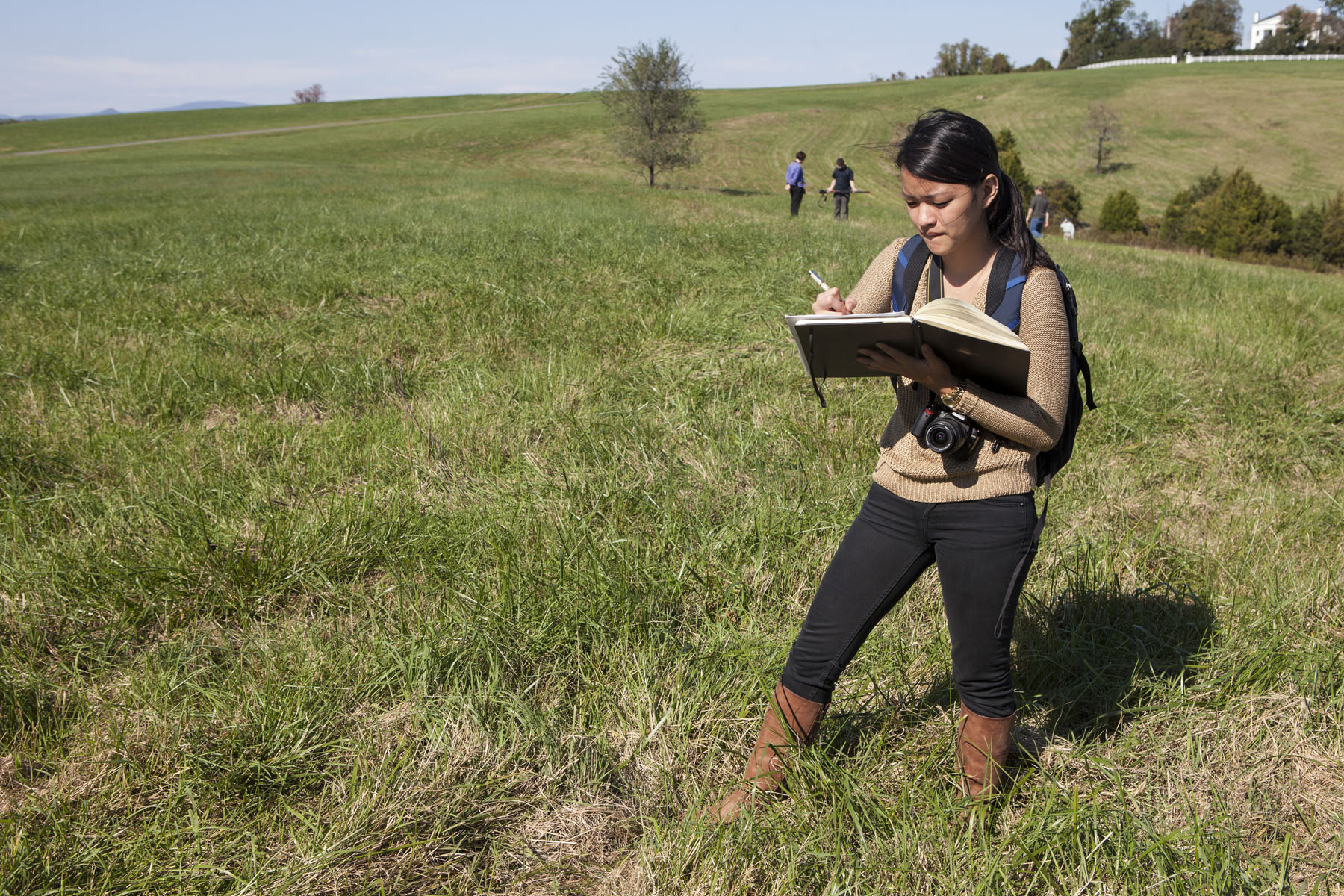With the Blue Ridge Mountains to the west and the ridges of the Southwest Mountains in view, University of Virginia Architecture School students scattered over the landscape at Westover, an almost 325-acre property located off Old Garth Road near the U.S. 250 Bypass and owned by the UVA Foundation. They sketched, took pictures and walked the land as part of their research to design a Center for Integrated Medicine and Well-Being that blends health perspectives from the East and West. The exercise is to explore the design for a collaborative, integrated facility.
The 28 third- and fourth-year students in a design research studio, led by architecture professors Schaeffer Somers and Peter Waldman, are devoting eight weeks to the design initiative. One of the school’s research themes addresses how buildings, landscape and community design impact health.
The course’s comprehensive approach joins the study of structure to the understanding and design of a health-care facility that blends traditional Western medicine and practices based on ancient Tibetan Buddhist philosophical principles, astrology and the close relationship between the mind and body.
The Arura Medicine of Tibet group, based in the city of Xining, Qinghai province, in the northeast of the Tibetan areas inside China, is partnering with U.Va.’s Department of Family Medicine and working closely with department chair Dr. M. Norman Oliver on ways to heal the mind and body and hopefully build a facility to bring together the two perspectives of health care.
Fourth-year student Jessica Hays said she took the course because she wanted to work on a project that had “real-life” stakeholders. “I like that our project is focused on a relevant social issue; it gives us the opportunity to problem-solve through architecture,” she said.
“Health care is such a hot topic in the news and we are being given a chance to consider it from a completely different angle – integrating Western and Tibetan practices.”
The course incorporates the principles of the school’s four disciples: architecture, landscape architecture, history and planning, Somers said.
In one session, landscape architecture professor emeritus Reuben Rainey, co-director of the school’s Center for Design and Health, talked with the students about the importance of integrating landscape into medical facilities. Rainey, who teaches a class on “Healing Spaces,” shared evidence-based research about the impact landscape has on healing. One study he cited showed that hospital patients who had views of a park-like setting outside their windows took fewer medications and were released earlier.
Rainey added that incorporating these landscape views and settings also help to relieve stress in caregivers.
The Westover site, with its meadows, forest edge and mountain views, “has a tremendous potential for a healing setting,” he said.
He added that U.Va.’s Emily Couric Cancer Center fits the criteria for therapeutic building design: exposure to natural light; an ease of navigation through the building that reduces stress; contact with nature, both real and virtual, such as through paintings; good ventilation; reduced noise level; and private patient rooms.
Dr. Margaret Plews-Ogan, director of the U.Va. Health System’s Division of General Medicine, Geriatrics & Palliative Care, told the group that integrating Western and Eastern medical perspectives is important. “No one has the corner on health and healing,” she said.
Students had an opportunity to hear the Dalai Lama speak twice during his Oct. 11 visit to Charlottesville – talks on “Compassion as a Global Remedy” and “Compassionate Care in 21st-Century Medicine.” The latter event, which included U.Va. clinicians, provided them with a broad view of the links between Tibetan and Western medicine.
A presentation by an Arura representative about Tibetan culture, building forms and placement and their relationship to the landscape provided a perspective to how health and well-being permeates their culture. The session kicked off with an introduction by Dan Haig, who acts as a cultural interpreter for the group, who introduced the students to the geology and history of Tibet and India and the cultural context of Tibetan Buddhism.
“Dan Haig was able to give insight into traditional Tibetan medicine,” third-year student Tammy Teng said. “It is more in tune to the body and employs deeper analysis into a singular diagnostic method and in response uses natural medicine – acupuncture, physical therapies, etc. – and that would affect the way a space is designed.”
The Arura representative, Gyaltsen Sangpo, a native Tibetan, explained the long tradition in carefully siting cities, urban forms and temples in the landscape based on Buddhist teaching.
The goal is to break down the complexity of the site and the program for the Center for Integrated Medicine and Well-Being and help the students work together to integrate analysis into design solutions, Somers said.
“Landscape is extremely important to architecture, as is the siting of buildings, especially on a site like Westover with so many breathtaking views,” fourth-year Henry Hofmann said. “In this site, I believe that landscape and views to it will be especially important in promoting wellness amongst people who will come to this place.”
Media Contact
Article Information
October 30, 2012
/content/school

